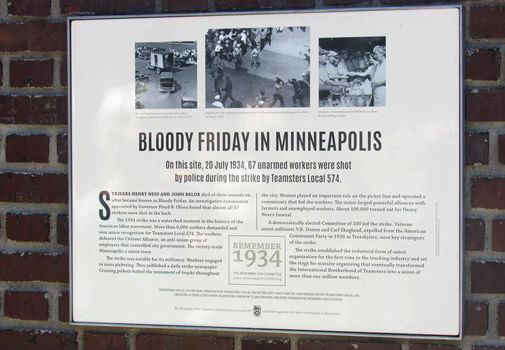
MINNEAPOLIS (PAI) — One day shy of the 81st anniversary, 200-plus people gathered in the warehouse district in downtown Minneapolis on July 19 to unveil a plaque marking the spot where city police opened fire July 20, 1934, on unarmed striking members and supporters of Teamsters Local 574. In what became known as “Bloody Friday,” two workers later died of their wounds and another 60-plus were injured.
“Bloody Friday” was a pivotal event in the 1934 Teamsters strikes in Minneapolis, a series of strikes which began in the bitter cold of February and continued through a blistering hot summer. The strikes made Minneapolis a union town and broke the power of the Citizens Alliance, a secret business-backed organization which thwarted union organizing for years.
And the business-incited violence associated with the strike was in turn one of the key events that pushed Congress and President Franklin Delano Roosevelt to enact the National Labor Relations Act, a year later.
Some two dozen descendants of 1934 strikers, including two granddaughters of Henry Ness, one of the men killed, attended the July 19 ceremony. The plaque was installed by the Remember 1934 Committee with the support of Teamsters Local 120 and other donors, including the Minneapolis Regional Labor Federation.
Descendants of 1934 strikers, including Donna Severson, held signs featuring photos of relatives who participated. Severson said her father, Don Severson, and her uncle, Jack Maloney, were among them. “I think it’s great they’re finally recognizing the strike, what it did for Minneapolis – because you don’t learn about it in school,” Severson said. Did she? “No, not at all.
“I was actually out of the country and taking an American history class when I read ‘Teamster Rebellion.’ That’s when I saw a picture of my uncle Jack and learned about it.”
“Welcome to a sacred place,” said master of ceremonies Bob Kolstad, member of the Remember 1934 Committee and of Teamsters Local 320. “We believe the plaque we are unveiling today is the first public monument to the labor movement in Minneapolis.”
Kolstad ran through the history of the 1934 strikes and how the Teamsters had shut down all truck traffic in the city in July. On July 20, 1934, he related, the police set a decoy truck in motion – which was intercepted and stopped by a truck with roving pickets. Police then opened fire on the picketers in the truck and in the streets. Of the two men who died, Kolstad didn’t mince words: “They were murdered.”
He then told more about the two men who died of their wounds from “Bloody Friday.”
“John Belor was an unemployed fellow worker who was here that day in support of the strike,” he related. Henry Ness was a striking truck driver, a World War I veteran, who would die leaving a wife and four young children, Kolstad continued. “He was laying on the ground at the time he was shot.”
The bloodshed did not break the strike. The Minneapolis Labor Review reported that 100,000 people either marched in the funeral procession for Henry Ness or watched it in silence as it went through the city’s streets. The strike continued.
By late August 1934, a settlement was reached with the help of federal mediators. In part, some scholars believe, the settlement occurred because FDR’s administration intervened and threatened to call in federal loans to Minneapolis banks.
The union had won most of its demands and “Minneapolis became a union town,” Kolstad said.
Descendants of 1934 strikers listening to the speakers included Linnea Sommer. Last year, she told the Minneapolis Labor Review: “My grandfather, Chester Johnson, was in the Socialist Workers Party and was involved in the strike… All I know is that it happened and my grandfather was in it. I know it broke the back of the Citizens Alliance and made Minneapolis a union town.”
The “Citizens Alliance” was a business-backed organization which worked to quash union organizing efforts in Minneapolis from 1916 into the early 1930s. During the 1934 strikes, the Citizens Alliance deployed its own private army on city streets to battle striking Teamsters and their supporters. Famous strike photos depict fierce hand-to-hand combat.
Cherene Horazuk, granddaughter of 1934 striker Harry Horazuk and president of AFSCME Local 3800 – and a featured speaker on July 19 — held a sign with a photo of her grandfather. He was 17 at the time of the strike. Her grandfather died when she was 8 years old, so she never got to talk with him about the strike but she heard his stories about it through her dad and her aunt. Horazuk and other speakers related the 1934 strike to current events.
“Labor and working people are under attack today like they haven’t been since the 1920s. We see a lot of hand-wringing by the labor movement today…I want to point to the 1920s…Labor was fighting but they weren’t winning.” But, Horazuk continued, “It was the people fighting in the 1920s who brought about the 1930s, because they refused to give up.”
Horazuk asked, what was it that won the day for workers in 1934? Filing a grievance? No. Was it getting a card check? No. Was it a court ruling? No. “What made Minneapolis a union town was a strike…It was organizing and acting as a class…It was determined and collective action…It was the nameless and the named…It was 100,000 people who turned out for the funeral of those who died.
“For all of those who are wringing their hands, look to the past…We know being in a union gives us a voice, gives us more power, gives us better wages,” she urged.
Thomas Keegel, the Teamsters’ secretary-treasurer emeritus, came out of what is now Teamsters Local 120, successor to the former Teamsters Local 574, which waged the strike.
Keegel told the crowd he got to know veterans of the 1934 strike when he first became a Teamster in 1959 and worked at Sterling Cartage. “These guys, they were proud that they stood up and fought that battle…They had nothing. They were coming off the greatest depression in the history of this country…Those strikers fought for respect and dignity.”
He recalled a turning point in the strike, after the Citizens Alliance army violently attacked striking Teamsters. “When these strikers knew they had a war on their hands – and they had a war – they came back with the axe handles and they came to fight.”
He cited the Teamsters’ motto: “The rights which labor has won, labor must fight to protect.” Keegel added: “That is your job and my job – no matter what. We’re at war today… History repeats itself.”
He noted how some of the big notoriously anti-union employers like Wal-Mart recently have offered wage increases. “The employers are getting nervous,” Keegel said. “When we are fighting a war, we are fighting a war with somebody out to destroy us… We’re at war and it’s a war we cannot lose. We must win.”
John Hanson, son of 1934 striker John Hanson, and a member of the Remember 1934 Committee, showed a picture of his father holding him, as a baby. His father drove a coal truck, his uncle was one of the roving picketers, and his aunt volunteered in the strikers’ commissary and infirmary. His father, who taught him about the strike, “served on the elected Committee of 100,” which guided it.
Hanson’s father was at the “Bloody Friday” encounter but happened to get off the picketers’ truck just before it rounded the corner and intercepted the decoy truck, which then led to the police bullets. Hanson’s father saw a friend get shot in the back. An official inquiry into the shootings, commissioned by Gov. Floyd Olson, found most of the strikers shot that day were shot in the back.
“We marvel today at the description of those involved in the 1934 strikes…These ordinary men and women achieved extraordinary results,” Hanson said. And when his father told stories about the strike, Hanson added, “the one word he used most was – plan.”
In first strategically striking the Minneapolis coal yards in the winter of 1934, deploying roving pickets, organizing the unemployed to support the strike, facing down the police and Citizens Alliance in the streets with military tactics, publishing a daily strike newspaper, setting up a commissary and infirmary, the strikers showed a high level of planning and organization.
Hanson concluded: “For the sake of the heroes of 1934, whom we honor here today, let’s join in seeking a better world.”
Steve Share, Minneapolis Labor Review editor
For a synopsis of the 1934 Minneapolis Teamsters strikes, visit here.
Photo: The plaque features images from the 1934 strikes and text including a summary of what took place and why the strikes were important. Minneapolis Regional Labor Federation Facebook.
.


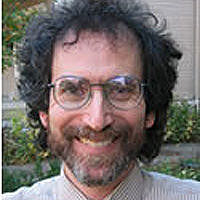
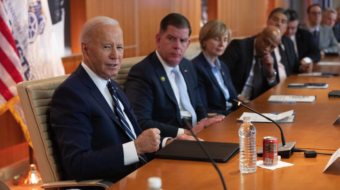
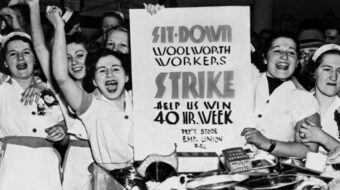
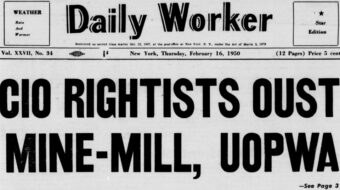






Comments